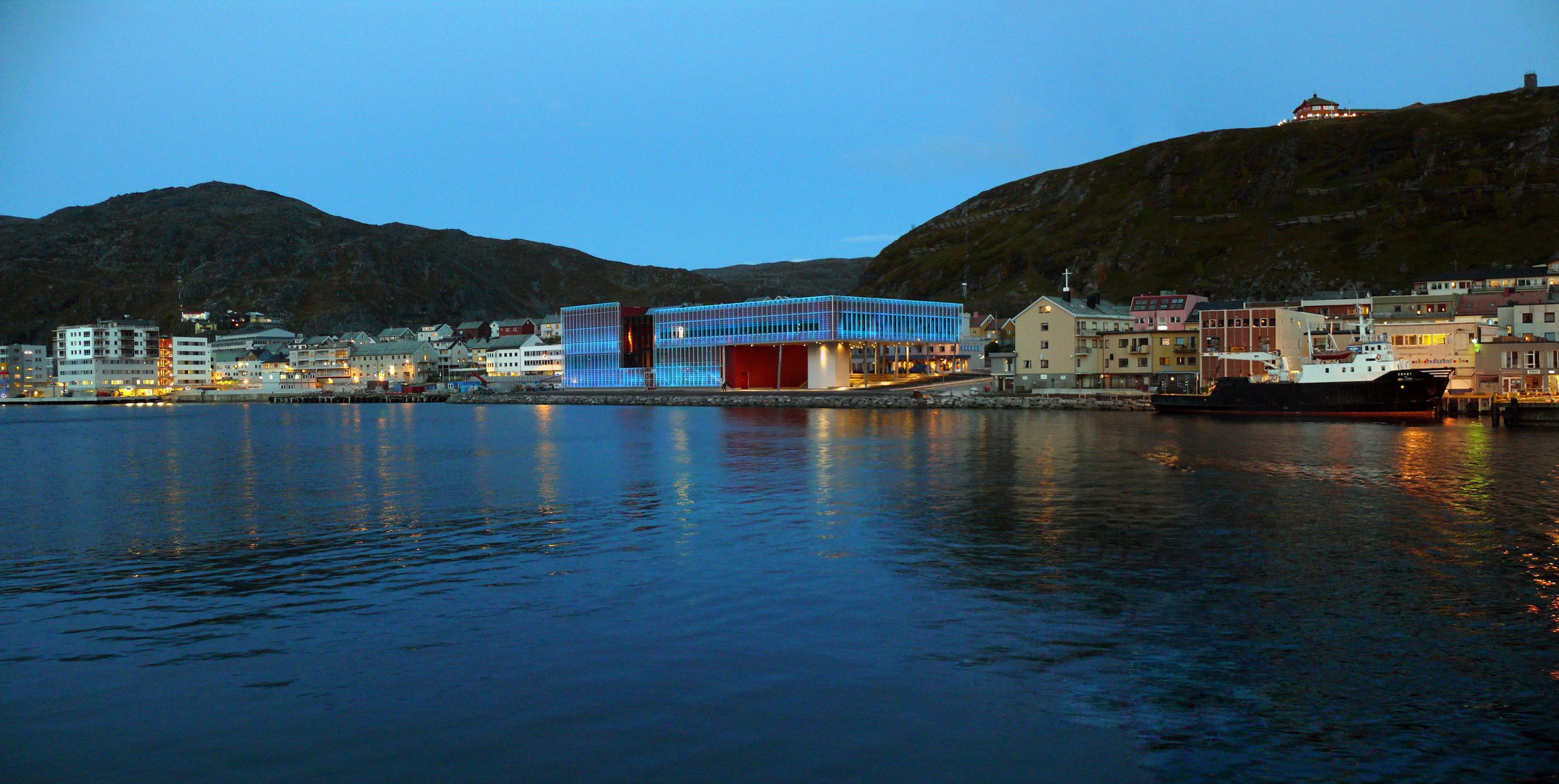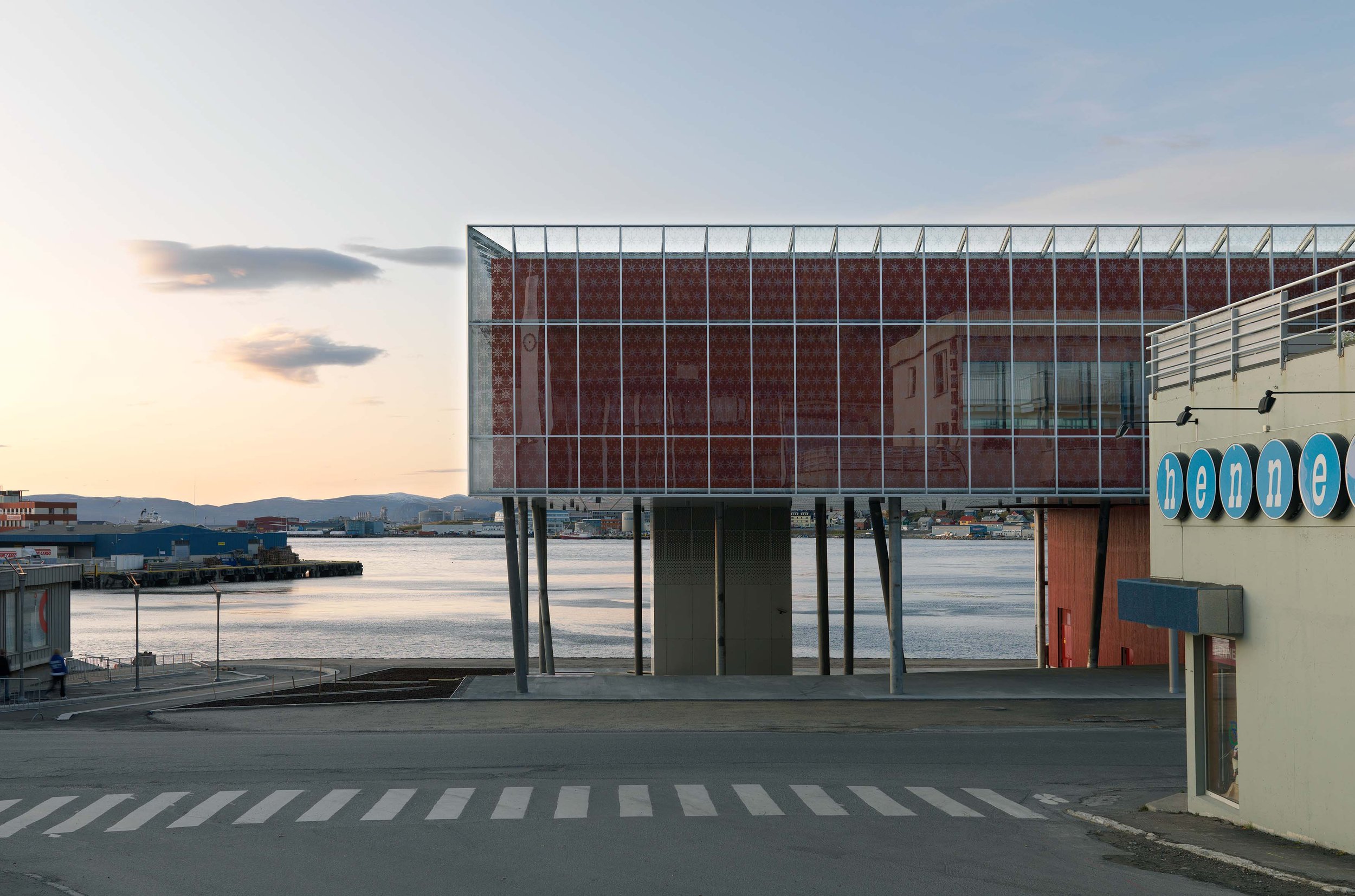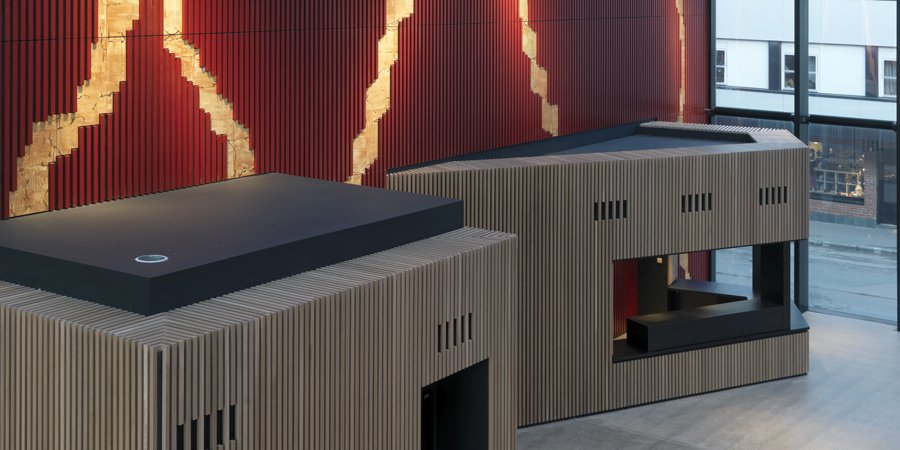
Hammerfest Kulturhus
How to mirror the northern landscape?
TYPE OF PROJECT: Culture center
LOCATION: Hammerfest, Finnmark
CLIENT: The Municipality of Hammerfest
SIZE: 5000 m2
TIMEFRAME: 2004–2008
PROJECT STATUS: Completed
When the winter months lay its darkness over Hammerfest, a luminous blue façade by the waterfront vibrates almost like the famous northern lights. When the daylight once again reach the arctic regions, the warmth from the red-painted cladding emerges through the glass shell and creates a backdrop for reflections of the sea and the mountains. With the Arctic Culture Center (AKS), the harbor area of Hammerfest is revitalized, and the town becomes the cultural center the region has been missing for so long.
Arctic Culture Centre (AKS) emphasizes the unique role Hammerfest has as the northernmost town in the world – north of the Arctic Circle, at 70.7 degrees north. The town is one of the most important tourist destinations in Northern Norway with around 250 000 visitors each year. Like so many other remote communities, Hammerfest has experienced a depopulation increase in recent years. The goal for the new culture center is to create an iconic building with a broad cultural content that will attract newcomers and increase the flow of tourists.
Despite the fact that Hammerfest is located north of the Arctic Circle, the coastal climate gives the town mild winters that keep the harbor free of ice. Fisheries and the fishing industry has been the primary business here, and for years, the Findus factory was situated on this spectacular seaside lot. Replacing the old industry with a new public center has transformed this part of the harbor area, and a new link to the town center has been established along the water’s edge.
«The Arctic Culture Center establishes a link to the town and the sea in a clever way.»
Critic Lotte Sandberg from Aftenposten.
Light
Art is an integrated element in the entire architectonic design. The façade makes up the most striking element, and alludes to the unique daylight conditions in this region. Not only can this town offer winters where the sun never rises and summers where the sun never sets, the northern lights are also an attraction.
The two-piece façade has an exterior, transparent layer decorated with snow crystals and ornamented with strips of LED lights. When the LEDs are lit, it is as if the whole building wakes up and vibrates in a bluish purple light that create shifting reflections on the water surface, almost like the northern lights. The luminous façade helps brightening up the town throughout the winter darkness.
During the summer months, when daylight refuses to yield to the darkness, an interplay between the two façade layers emerges. The red painted wooden panel behind the glass façade emits a warm glow where the snow crystals on the glass panes makes up a playful element on closer inspection. Moreover, reflections from the sea, the mountains and the sky will appear on the glass panes from different angles.
On one side, the building has a gigantic overhang that is supported by a row of concrete pillars. The open design establishes a link between the street level on the back of the building and the sea. In addition, this feature creates an outdoor public space with a tribune in cast concrete, almost like an arctic amphitheater. The artwork is retracted under the overhang in the shape of knit motives on the square pillar. The weather is an integrated part of life in polar regions, and the people of Hammerfest flock to their arctic amphitheater all year around. During the dark period, it is almost as if the amphitheater is enclosed by a bluish veil from the luminous exterior walls.
In the foyer, the shimmering northern lights are burnt into the walls in the piece of art by Marius Martinussen. A series of gold-foliated stripes shoots up the red rib wall and gives the room a glorious, almost sacral character, while the impressive ceiling height and the large floor-to-ceiling windows let nature penetrate the building. The staircase leads up to a bridge, where the traverse over to the main hall of the center, is an attraction in itself. Up here, the view of the North Sea is spectacular – to put it mildly.
The foyer is the heart of the building with a floor plan designed to feel intuitive. All of the functions in the building are interconnected in this room. In addition to the main hall, a number of rehearsal rooms and offices have been placed on the top floor. The two movie theaters can be found on the floor below. Accommodations have been made for flexible food and drink operations that may be changed as new leaseholders move in.
Artist Marius Martinussen was involved in the project from day one and has applied a layer of golden acrylic paint on the sections between the acoustic rib walls. Spotlights light up these gold beams, which provide the room with a warm glow.
Practical functions such as wardrobes, ticket booths and staircases are shaped in cubistic manner in bright oak and stick out from the red walls. The ribs have an acoustic function in addition to visually breaking up the huge surfaces.
«This cultural initiative by Hammerfest will probably boost people’s desire to live there, draw tourist and become a part of a major development of knowledge and innovation.»
Critic Lotte Sandberg from Aftenposten.
It is as if Hammerfest has once again strengthened its position as a visionary region with the new culture center. As early as in 1889, the town showed itself as pioneers when they sent a delegation to the Universal Exposition in Paris to look at a power generating turbine. Two years later Hammerfest got, as the first town in Northern Europe, electric streetlights.
This building should be open and accessible for everyone and inspire recreation and social interaction across the cultural activities taking place there. Hence, the café area is an important element in order to bring in visitors. By placing the café close to the gigantic windows, a totally unique social zone with a view over the North Sea has been created.
The Arctic Culture Center is a multipurpose building with a music and performing arts education and a workshop meant to satisfy the requirements of a professional theatre, rehearsal rooms for dancing and a movie theater, while still being open and accessible to all kinds of visitors. The building serves as a central platform for cultural activities and conferences in the region.




















